
This picture was taken over a week ago, showing the wheat field to the east of our house. The wheat is even higher now, and in other fields I can see small shoots of corn starting to poke up through the dirt. Acres of brown are turning into acres of green. But they'll turn back to acres of brown unless we get some rain soon. The rain clouds in the picture above only delivered a few drops of wetness, not nearly enough. We are very dry. We're supposed to get rain today -- everybody is hoping for it, praying for it. If it doesn't come I'll have to go out and water my garden, the third time this spring.

Our alfalfa is lush and green as well. It is already about 18" tall, tall enough for a pop-fly baseball to be hit inside and lost forever. Or at least until mid-June, when the farmer will come through for the first cutting. After the first cutting I usually take a walk through the fields and pay tribute to whatever unfortunate birds decided to build nests in the pre-cut alfalfa. Sometimes I see just broken egg shells, sometimes I see feathers. If that isn't sad enough, the day after the cutting I sometimes see a lone male pheasant wandering around our property, looking for his mate and their nest. After a few days of searching he gives up and wanders away.
Some farmers delay the first cutting until after the nesting birds (pheasants, grouse, meadowlark, etc.) have hatched and flown away. That usually pushes it back until August 1, meaning that instead of three cuttings of hay there would be only two. Not many farmers do this, for economic reasons. I'm contemplating asking our leasing farmer to do this, however. He would probably be more agreeable to this suggestion if I lowered my land lease. I guess I need to put my money where my mouth is.
I've done one other thing to help the birds, though. I have ordered signs from our friendly DNR office to put up along our road right-of-way (the strip of grass running next to the gravel road on the edge of our property). The signs tell folks that this area is off limits. Off limits to haying, ATVS and chemicals. Actually, road right-of-ways and railroad right-of-ways are some of the best remaining locales of native prairie grass and wildflowers out here in farm country. This makes right-of-ways prime habitat for wildlife. And prime spots for birds who nest on the ground or in tall grass.

This is nesting season for our wild birds, right here and right now. I'd better hurry up and put up those roadside signs, and hurry up and call our farmer. The only thing I want to find in our newly-cut alfalfa field this summer is a lost pop-fly baseball.








